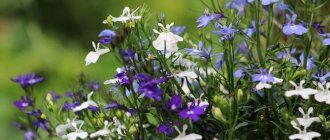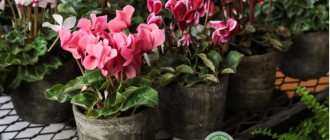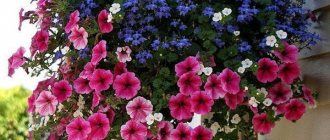Lobelia is an annual slow-growing plant that belongs to the bellflower family. It is distinguished by its creeping development and blue flowering, which is very rare for plants. This fact is very popular among summer residents, and therefore lobelia is quite often present in their garden plots as a decoration. Today we will talk about how to properly grow this flower and what care it needs.
The flowers of the attractive plant come in a variety of colors - white, purple, red and blue. This makes it stand out among the blooming garden and makes you pay attention to where it is planted. For this reason, lobelia is not only present in many summer cottages, but also reproduces successfully. Moreover, each person can easily determine the variety that suits him best. This is possible due to their wide variety.
Types of lobelia
The plant's homeland is South Africa, but this does not mean that the plant can normally exist only in distant lands. It feels great in our region. At the moment, there are more than 300 different types of lobelia in the world, and they are all slightly different - annuals and perennials, herbaceous and shrubs, as well as cultivated species.
Among all the species known to us, we can highlight the main ones that will take root well in your dacha:
- Lobelia perennial, erinus;
- purple, cardinal;
- Dortman, swollen;
- climbing, hybrid;
- And also varieties: Ampelnaya, Blue, Aquarium, Cardinalis, Kustovaya, Cascade, Ezhevidnaya, Riviera, Crystal Palace, Emperor Willy, Inftala and some others.
What is this flower
Lobelia is one of the most popular types of flowers for the garden or cottage.
Lobelia is one of the popular plants among gardeners. It attracts attention with its delicate flowers, which grow in dense groups, and the ampelous forms hang beautifully from the flower pots, reminiscent of a waterfall. This plant is a perennial shrub of the Bellflower family, which in our country is grown, in most cases, as an annual. The flower's homeland is South Africa, where the flower grows on wet and rocky cliffs, although it can be found almost all over the world in tropical and temperate climates. In total, there are about 300 species of lobelia, of which only 20 are cultivated.
Photo gallery
How to choose a variety
Lobelia came to Europe from North America and southern Africa. Today this flower is widespread; it grows on almost all continents of the earth. Botanists classify lobelia as a member of the Bellflower family, identifying more than three hundred species of this plant.
Attention! Lobelia of any variety can be dangerous to humans (especially children). The fact is that this plant is medicinal; it is actively used in folk and traditional medicine. Like all medicines, in large doses lobelia is poison!
There are several varieties of this plant, differing primarily in the height of the shoots and the shade of the inflorescences. Most often, domestic flower growers grow:
- Lobelia bush (or Erinus), which grows in low balls covered with a large number of small flowers;
- an ampelous variety, the bushes of which are more loose and climbing; there are not as many inflorescences on them as on Erinus.
Bush lobelia is suitable for planting in flower beds and various landscape compositions (on an alpine hill, for example). But hanging varieties will decorate hanging plant pots, balcony boxes, window sills, and are suitable for growing in flowerpots and pots.
Important! A bag of ampelous lobelia seeds should have the words “climbing,” “cascading,” “pendula,” or “ampelous” on it.
Growing a hanging variety is somewhat more difficult than a bush variety. She is more whimsical and often dies due to improper care. Practice shows that the most persistent are those types of ampelous lobelia whose inflorescences are blue-blue in color. The white variety germinates more slowly and develops less well, but is also quite suitable for beginning gardeners. But it is better to avoid the purple or lilac varieties - they are very capricious and rarely produce abundant flowering.
The appearance of ampelous flowers is very characteristic:
- stems branched, angular;
- shoots have a reddish tint;
- stems drooping, reaching a length of 50-60 cm;
- leaves are shiny, dark green, small, lanceolate;
- inflorescences are two-lipped, small in size.
Attention! There are no ampelous varieties with yellow, red and orange flowers yet. Only upright bush lobelia has inflorescences of such shades.
How to grow lobelia correctly (video)
After sowing, there is no need to sprinkle the seeds with substrate. It is better to simply spray the surface with a weak solution of potassium permanganate (potassium permanganate) through the finest spray bottle. Then the container needs to be covered with glass, creating a kind of greenhouse for the seeds. The glass must be removed and wiped every day to avoid “steaming” the seeds. Otherwise, they will not germinate, but will simply rot.
If high-quality seed material is purchased, the first shoots will appear within 10 - 15 days after sowing.
The sprouted plants should be left in the greenhouse, but not under glass, but under a plastic bag so that there is more air under it. In order for small plants to grow faster, you need to place the greenhouse in the brightest place and often open the bag for ventilation.
There is no need to water the seedlings - it is better to moisten the substrate by adding a little water to a tray placed under the container with the young shoots.
Features of the plant
Currently, approximately three hundred species of lobelia are known, and all of them are wonderful decorations of the landscape. Caring for this plant is not easy and requires patience. But it's worth it.
Lobelia is an annual crop. The most common type is ampelous lobelia, which is grown both in open ground and in flower pots.
The first stage in the life of lobelia can be described as relatively capricious. Of course, many take ready-made seedlings, but it would be better to grow them yourself.
How and when to sow lobelia
Sowing of seedlings is carried out in small containers. Here everyone decides for themselves what will be more convenient. In the store you can buy peat pots that are best suited for this purpose. For lobelia, what is important at first is not so much moisture as the ability to “breathe”. The soil should be loose enough and allow air to pass through well. The seedlings will feel great in peat soil.
The best time for sowing is February. This is explained by the fact that seedlings of petunia and lobelia grow slowly, although the seeds themselves take root quite quickly, in 10-14 days. The sowing time can be postponed to a later time and planted in the spring, if you decide to sow directly to the permanent location of the flower. In this case, the seedlings will bloom later.
It is important to carry out sowing in compliance with all rules of agricultural technology. The soil is distributed in an even layer into the planting container and, after a little moistening, it is lightly pressed down. Lobelia seeds are small; to make them easier to place on the surface, some gardeners first mix the planting material with a small amount of sand, and then carefully sprinkle the soil with this mixture. You can distribute the seeds with a toothpick, the tip of which is moistened with water. The most convenient seeds for planting are in granular form. A small amount in a package should not be scary, because from each granule a bush will grow, which can then be planted into smaller fragments.
After sowing, there is no need to cover the seeds with soil on top. They need to be covered with film and a mini-greenhouse built. In the following days, you will need to make sure that there is no moisture under the film and remove condensation when it first appears. It is necessary to open the film every day so that the soil is saturated with oxygen. Excessive moisture leads to the only disease that occurs in lobelia - black leg. If for some reason the seedlings turn black, then the affected seedlings must be disposed of immediately in order to protect the rest. Stop watering until the soil dries completely and treat the soil with potassium permanganate. After this, you need to sprinkle the soil with river sand, pre-treated with steam. Petunia seedlings are treated in a similar way.
Diseases and pests
Different varieties of ampelous lobelia can suffer from fungal infections that occur due to waterlogging. Seedlings sometimes suffer from blackleg (blackening of the root collar). Affected seedlings must be removed and the soil ventilated. As a preventative measure, the soil is pre-treated with a 1% solution of potassium permanganate.
The leaves of mature plants may become covered with a white coating - this is a symptom of powdery mildew. If the disease is not advanced, only diseased leaves are removed, and the rest of the crown is treated with fungicides:
- Bordeaux mixture;
- "Tattu";
- "Topaz";
- "Fitosporin";
- "Profit".
As a preventive measure, it is better to perform such treatment a few days after transplanting ampelous lobelia seedlings into a flower bed.
Attention! If the leaves turn purple or reddish, this indicates a strong drop in temperature. In this case, the plantings need to be covered with fiber.
Dangerous insects include mealybugs and scale insects. spider mite To combat them, insecticides are used:
- "Aktara";
- "Agravertine";
- "Fitoverm";
- "Decis";
- "Confidor" and others.
Diving lobelia seedlings
Gardeners, gardeners and flower growers do not have a common opinion regarding picking seedlings. Some of them argue that this is unnecessary stress for a plant organism that has not yet matured. Others, on the contrary, believe that this is the only way to grow a high-quality plant.
But if vegetable crops that are grown as seedlings have more or less large seeds, then the grains of lobelia are so small that it is very difficult to sow it so that one plant grows in one container (glass). Therefore, it is usually dived 2 times.
If, despite your efforts, when sowing, the seeds sprouted too thickly, then they need to be thinned out. This will be the first picking of lobelia seedlings. This work requires extreme accuracy and patience. You can use a toothpick for this. It picks up an ascended plant (sometimes several) and places it in a separate cut plastic cup with substrate.
Many gardeners, instead of the first dive, simply break through excessively dense shoots.
When the first true leaves appear on the seedlings remaining in the common container, the time will come for the second stage of diving.
Young plants can be planted in another common container, in rows, between which there are gaps of 3 - 5 cm wide. Seedlings picked in this way can be watered between the rows.
You can plant in separate pots for seedlings, 3 to 5 plants per pot.
You can pick up lobelia seedlings using a teaspoon. Having picked up several plants with the tip of a spoon, pressing it to the substrate at the new “place of residence” of the lobelias, we make a hole for diving the seedlings. Then, we simply move the lump of substrate with the plants into the hole.
Some lobelia lovers, who have been growing seedlings of this plant for many years, advise trimming the tops of plants that have reached a height of 3 cm by a few millimeters. They say that “clipping” promotes branching of the plant.
The place of lobelia in landscape design
Lobelia is quite often used in landscape design. The flower looks great both on the balcony and in the form of “carpets” near ponds, in alpine slide compositions next to other perennials. In modern design, lobelia is widely used to create coziness in the corners of the garden, for which it is planted in flowerpots or containers. The most common places for planting plants at home are flower beds, borders, and hanging baskets.
In the flowerbed
Before planting a flower on a garden bed or flowerbed, you need to think about what the color scheme of the future composition will be.
Rabatka is a rectangular flower garden in the form of a narrow strip of about 2 m, located along a fence or garden path with other plants.
To combine with lobelia, the flowerbed must be formed from similar shades: blue, lilac, light blue, violet. This combination of colors looks quite attractive: crimson and white, blue and red, yellow and blue.
To combine with lobelia, the flowerbed should be formed from purple, lilac, blue and light blue shades
In hanging baskets
When growing ampelous species, such flowers look most beautiful in hanging baskets in the form of a ball - the plants are a continuous carpet of flowers that hides the frame. One of the easiest options for planting lobelia is coconut liners. Holes are first made in them, filled with soil and plants are planted on the outside of the container.
Ampelous lobelias look great in hanging baskets
In decorative flowerpots
Lobelia looks very attractive in decorative flowerpots, for which you need to choose the right “neighbors”. If you use low-growing flowers in tandem with it, then to diversify the composition you can plant plants with different leaf textures and flower sizes. Large diameter pots are perfect for such plantings. To add dynamism to the flower arrangement, you can combine compact plants with upright growing ones.
An original solution in landscape design would be to use a flowerpot similar to a round vase. In this case, the ampelous lobelia can be planted in the bowl itself, and small bushes of this flower can be planted at the foot, making a light backfill. To add some flair to your garden design, you can install several flowerpots of different sizes with contrasting colors.
To make lobelia in flowerpots look attractive, you need to choose the right “neighbors”
Tower of flowerpots
Lobelia stands out noticeably when grown in a flower tower, that is, pots stacked on top of each other. To form such a composition, take several clay pots with a difference in diameter of about 7 cm. After this, fill the lower container with soil and insert reinforcement, which is buried in the garden soil through a hole in the bottom, thereby ensuring the stability of the flower shelf. The remaining pots are placed on top of each other, putting them on the reinforcement and filling them with soil, followed by compaction. Lobelia is planted in combination with other flowers, starting from the lower pots, after which it is watered abundantly. In such compositions, blue flowers go well with purple and pink petunia, as well as white and red balsam.
As an example, a tower of pots is given, in which the lobelia will stand out noticeably
Growing and care
The plant is considered to be quite heat-loving, so it is worth choosing a sunny, quiet place for it, without drafts or cold wind, away from lush vegetation that can create shade. The flower also prefers high humidity and therefore requires constant watering.
Of course, you shouldn’t overwater the plant, but it would be very nice to water it moderately but constantly.
Lobelia blooms well and develops rapidly on sandy or loose loamy soils. If the soil is too saturated with fertilizers, mainly organic matter, then flowering will be poor, but the plant will be able to please you with lush and juicy foliage.
There is an interesting remark about the moisture-loving nature of lobelia, which was made by professional gardeners. It turns out that the plant does not tolerate rainy weather and high levels of precipitation very well. During this time, the flower may look sickly and lose most, if not all, of its bloom. But at the moment when precipitation stabilizes and natural humidity becomes moderate, warm and sunny weather sets in, the flower again gains vitality and pleases the eye.
Features of caring for lobelia
Feeding
Lobelia needs to be fed twice per season.:
- Before flowering begins , dry potassium fertilizers are applied during loosening, after which the soil is watered abundantly.
- During the flowering period , dry mineral fertilizers are added in the same way during the loosening process, or in liquid form at the root. This feeding, if necessary, can be repeated after a month.
Watering
Ampelia lobelia is a moisture-loving plant, so in hot weather it should be watered up to 2 times a day. The soil surface must be constantly moist. If the flower is grown in a pot where there is a limited volume of soil, you can add hydrogel or vermiculite to the soil to better retain moisture. The crop blooms profusely only on breathable soil, so it needs to be systematically loosened. However, this must be done very carefully so as not to damage the delicate roots of the plant.
Causes of poor flowering
As a rule, intense heat sets in in the summer, especially in July, when there is no escape even in shady areas or on balconies on the north side. Because of this, lobelia leaves begin to turn yellow and dry out. They will have to be cut or plucked regularly. It is during this period that the crop exhibits a weakening of flowering. The stems begin to stretch, acquire a yellow tint, and flowers appear very rarely. The problem can be solved by radical pruning, after which a second wave of flowering will occur.
Good to know! Lobelia should be trimmed so as to leave 5-10 cm from the shoots. After this, the plant grows back into a lush head and blooms two weeks later.
In addition to drought and heat, the cause of poor flowering can be unsuitable soil - rich in nitrogen mineral fertilizers or organic matter. Therefore, during flowering, the plant must be fed with a minimum nitrogen content or without it at all. But potassium sulfate will promote flowering, so abundant that no greenery will be visible among the inflorescences.
Useful tips
- Watering lobelia should be moderate. The soil should not be allowed to dry out until crusts form, but excess moisture can also harm the plant. Therefore, it is important that the soil is only slightly moist, this is especially true in mid-summer. A dried out crop will soon stop growing.
- The flowering of lobelia can be extended until the onset of frost ; to do this, you need to prune the bush every time it begins to bloom and seeds form. You should leave 5 cm above ground level from the shoots, and then fertilize the soil well. After two weeks, buds will begin to form on the bush again. You can do without pruning; you just need to regularly remove faded flowers and trim the bush.
- Lobelia can only be planted in a well-lit, sunny place. If the plant does not have enough light, flowering will become scarce. But here it is worth considering that this culture also does not like heat. Therefore, the sun should alternate with shadow.
- If the hanging plant is planted in a vase or flowerpot on the balcony, it is necessary to water it twice a day: in the morning and in the evening. This is explained by the fact that city air dries out the soil much faster. And if the lobelia is planted in a dark-colored pot, it will heat up faster, which means the soil will dry out faster.
- In order not to purchase lobelia seeds in the store, you can collect them yourself. To do this, you need to wait until the plant blooms. Then pick the flowers with already formed seeds and shake them over the paper. The seeds are quite small, so it is recommended to sift them and then remove them until spring.
Landing in the ground
Since cultivated plant varieties have a long growing season, lobelia is grown by seedlings, which is much simpler and more effective.
High-quality and prepared seeds should be planted in special seedling boxes in early March. The soil chosen for this is light, preferably with the addition of sand and peat. The seeds are planted in the soil literally 1 cm deep, without being particularly pressed down. If the seeds are very small, then they can generally be scattered over the surface without covering them with soil. Next, the soil is lightly moistened with a spray bottle and the boxes are covered with a special film for greenhouses or glass. It is not recommended to open the cover before the seeds have sprouted, as this may harm them.
After you notice the first shoots, the plant can be planted. This usually happens twice.
Initially, it is necessary to make the distance between the shoots no more than two centimeters, but during the second dive, when small bushes are formed, about 6 cm.
When the bushes get stronger and the air temperature stabilizes, and usually this is in the first half of June, the plants can be transferred to open ground. During this period there is no threat of frost, and small plants should take root well in warm soil. Please note that when transferring, the distance between the bushes should be about 15 cm, so that when the lobelia grows, it does not interfere with neighboring plants. Also, good ventilation and comprehensive heating and lighting are the best prevention of possible diseases.
For perennial types of lobelia, propagation by plant division is possible, and cuttings are also possible. In fact, the plant loves renewal and transplants, which have a good effect on external and internal vital indicators. Therefore, systematic rejuvenation is required, which is performed once every two years, on average.
Simple tips like these will tell you how to grow lobelia, how to provide it with care and plant renewal. But there is another important point - preserving the flower in winter, which we will talk about in the next section of the article.
Proper sowing of seeds
How to grow fuchsia from seeds at home
The sowing stage is the most difficult stage when growing lobelia. This is because the seeds are very small, similar to sand. Therefore, it will be difficult for novice flower growers, but below you will get help. For beginners, it is advisable to use seeds in granules. In this case, sowing becomes much more enjoyable. Caring for lobelia is not very labor-intensive. The best option is to prepare the seedlings in advance instead of sowing the seeds directly into the soil.
Attention! Lobelia begins to bloom only three months after sowing the seeds. But a plant that was planted immediately in the ground will bloom only in the fall.
Lobelia Seeds
How to preserve lobelia in winter
If we are talking about adult plants, then they can be moved to a warmer room, for example, into a house. You can preserve lobelia until spring in ordinary flower pots. To do this, you will need to transplant the plants into pots, cut them down to the lower leaves and bring them indoors. It should be stored in a cool, bright place, not allowing the substrate to dry out. In such conditions, the flower will easily overwinter and will be ready for the next transplant into the ground in the warm season.
It is better not to grow young lobelia before winter, as the plant may not have time to get stronger and will simply die. It is much easier to protect mature flowers from the cold or to grow them again in the spring.
Lobelia at home is a wonderful plant that will decorate the area with carpet compositions and easily help in the design of garden borders in the warm season. In late autumn and winter, the plant will become a spiritual delight on the windowsill or even on the balcony.
Lobelia ampelous: growing from seeds
Florists grow a wide variety of plants. Lobelia ampelous attracts with its beautiful flowers of various shades, pleasing to the eye until deep frost. Plants with small inflorescences are planted in boxes or hanging flowerpots. The flower goes well with other representatives of the flora. How to grow this beauty and care for it is of interest not only to novice gardeners, but also to those who have extensive experience.
What does a flower look like
The most popular variety of lobelia, which is grown by gardeners in different climatic regions of Russia as an annual, is “Erius”. The flower comes in a variety of forms. The plant can have drooping shoots, creeping, spreading. These species are often used to decorate borders and create flower waterfalls. Compact types of ampelous lobelia are often grown as indoor perennial plants.
The most popular varieties are listed below:
- "Regatta Serpentine" - ampelous lobelia with amazing fan-shaped flowers in light pink shades;
- "Regatta Blue" - flowers are dark blue or sky blue;
- "Regatta Special" - annual lilac-light bud;
- "Reggata Mix" has a wide variety of bud colors;
- "Anabel" (Anabel Violet Whiskers) - has light lilac and blue blooms;
- “Sapphire” - lobelia blooms with purple buds.
- Red Cascade - buds of dark pink or pale crimson;
- Dortman - this species is listed in the Red Book, there are very few such plants left, it can withstand frosts down to -35 degrees.
Lobelia for home and garden decoration
Previously, lobelia flowers were used by the Indians of North America as tobacco. Inhaling the smoke of this plant caused a feeling of a slight narcotic intoxication. The extract of this flower has an anti-asthma effect, and some tobacco manufacturers add it to their product. This South African flower, which is not an annual flower in the wild, needs to be planted every year in our climate.
Rooted lobelia does not require special attention. The plant will grow on its own, and a bush up to 25 cm high will grow from small round tufts. Lobelia will perfectly complement any flower bed, flowerpot or garden bed. You can create an interesting composition from multi-colored bushes; it will serve as an excellent frame for the lawn.
The most popular varieties with photos
There are many varieties of lobelia that differ in color: white, blue, purple, lilac, red. Let's look at the most popular of them.
Sapphire - the plant is endowed with lush and hanging stems, reaching a length of 35 cm. The variety blooms with small, blue flowers with white spots on the petals.
Lobelya Sapphire is endowed with lush and drooping stems reaching a length of 35 cm
Emperor Willie is a dwarf variety with a bush height of no more than 10 cm. The flowers are blue. This variety is excellent for border plantings.
Emperor Willy is a dwarf variety with a bush height of no more than 10 cm
Crystal Palace - the variety is distinguished by abundant flowering with many small flowers blooming simultaneously on the bush. The color of the flowers is deep purple.
The peculiarity of lobelia Crystal Palace is abundant flowering with many simultaneously blooming small flowers on the bush
Cambridge Blue - the variety has low-growing and lush bushes with branches up to 10 cm long. The flowers are small in size, pale purple in color with a blue tint.
The Cambridge Blue variety has low-growing and lush bushes with branches up to 10 cm long and pale purple flowers with a blue tint.
Lobelia Riviera is an annual plant that blooms throughout the season and reaches a height of 10 cm. The flowers are bright pink or dark blue. During the period of abundant flowering, the leaves are almost completely hidden by the flowers. The variety is best suited for planting on borders or in boxes on balconies.
Lobelia Riviera blooms throughout the season and reaches a height of 10 cm
Miss Klibran is a wide bush with a flowering area up to 30 cm in diameter. The plant grows up to 15 cm, the flowers are bright purple with a white center.
Lobelia Miss Clibran has a flowering area up to 30 cm in diameter and reaches a height of 15 cm
Blue fountain - the bush is formed from 6-8 stems no more than 30 cm long. The branches resemble a blooming blue fountain. The flowers are characterized by a blue color with a white spot.
Lobelia variety Blue Fountain is formed from 6–8 stems up to 30 cm long, and the branches resemble a blue fountain of flowers
Collection and selection of seeds for planting
It is believed that ampelous lobelia is more demanding to grow than the bush variety. In fact, there are varieties that are distinguished by their unpretentiousness: all flowers that are blue or blue in color. White specimens germinate worse and develop more slowly, so when sowing you should always take into account the fact that not all seeds will germinate. Lilac and violet lobelia are even more capricious. Therefore, its cultivation should be taken more seriously. But with proper care, you can count on abundant flowering of any of the species.
When choosing seeds, you need to carefully look at the integrity of the packaging and the shelf life of the product. It is better to take fresher specimens, since they have a higher germination rate.
Important! If you collect seeds yourself, you need to remember that in this case the bushes are not pinched or trimmed. When seed boxes appear on the shoots, they are cut off and placed in a glass for several days. During this time, the seed material will spill out on its own and can be stored in paper bags.










